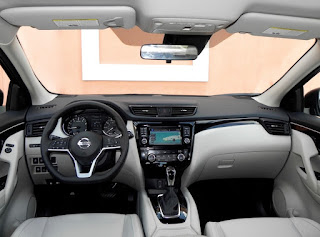2017 ROGUE SPORT A SMALLER VERSION OF NISSAN’S POPULAR ROGUE CROSSOVER
Perhaps in an effort to capitalize on the popularity of the Rogue, which was the company’s No. 1 seller in 2016, Nissan has come out with a slightly smaller version of the compact crossover that it has dubbed the Rogue Sport.It shares the same platform as its big brother and offers several of the same convenience and safety features — like Nissan’s Intelligent Cruise Control, Forward Emergency Braking with pedestrian detection, lane departure and blind spot warning, and rear cross traffic alert — as the Rogue.
LED headlights, a power sliding moonroof, Apple’s Siri Eyes-Free system, heated front seats, remote start, and Nissan’s Around-View monitor system are available on the Rogue Sport, just like on the full-size Rogue, and you also have a choice of front-wheel or all-wheel drive.
But this is no knockoff. The interior has a nice ambiance about it. There was no skimping on the Rogue Sport when it comes to styling or cabin comfort.
So what are the differences?
The most obvious, of course, is the size.
At 172.4 inches long, the Rogue Sport is about a foot shorter than the Rogue. This results in slightly less legroom in the second row for the Rogue Sport (33.4 inches to the Rogue’s 37.9), though the front legroom is virtually the same (42.8 in the Rogue Sport, 43.0 in the Rogue). At 104.2 inches, the Sport’s wheelbase is just over two inches shorter.
The rear cargo area in the Rogue Sport is smaller, but actual capacity depends on the model.
The Rogue Sport S trim offers up to 22.9 cubic feet with the second row of seats upright and 61.1 with it folded compared to the Rogue’s 32.0/70.0, respectively.
The Divide-and-Hide stowage system, which gives you an area underneath the rear cargo floor to store items, is standard on SV and SL trims and trims storage capacity to 19.9 and 53.3 cubic feet overall.
The Sport’s width is virtually the same as the Rogue (72.3 and 72.4 inches), but the Rogue is about six inches taller than the 62.5-inch Rogue Sport.
 All that said, you’d probably have a hard time singling out the Rogue Sport in the parking lot were it not for the “Rogue Sport” labeling at the left rear.
All that said, you’d probably have a hard time singling out the Rogue Sport in the parking lot were it not for the “Rogue Sport” labeling at the left rear.Even the wheels are close enough in size. The Rogue Sport S gets 16-inch steel wheels and the SV and SL get 17- and 19-inch alloy wheels. The Rogue offers 17s and 18s depending on the trim wth 19s as an option on the top-of-the-line SL.
Under the hood, the 2017 Rogue Sport comes with a 2.0-liter inline 4-cylinder engine that is rated at 141 horsepower at 6000 rpm and 147 pound-feet of torque at 4400. Numbers for the 2.5-liter 4-banger in the Rogue are 170/175, respectively, so yes, you’re going to get less of a kick from the Rogue Sport.
Mated to a CVT (continuously variable transmission) with sport mode, fuel economy for the Rogue Sport is 25 miles-per-gallon city, 32 highway and 28 combined with FWD, 24/30/37 for AWD. Those are nearly the same numbers as the Rogue (which with the mid-year enhancements it received is listed as a 2017.5 model).
As you might expect, the Rogue Sport does have an advantage when it comes to MSRP.
The Rogue Sport S with FWD starts at $21,420, and the most expensive Rogue Sport is the SL with AWD that opens at $27,420 before the $960 destination and delivery charge and options are added on.
MSRP for the full-size 2017.5 Rogue starts at $24,420 for the S FWD and runs on up to $31,710 for the SL AWD. Hybrid versions of the Rogue in all three trims run from $26,640 to $32,910.
What I liked about the 2017 Nissan Rogue Sport: The Rogue Sport shares its bigger brother’s attractive looks both inside and out. The front cabin is roomy, and operation of the NissanConnect system with navigation is easy enough, though responses to voice commands sometimes faltered. (No, I don’t want SXM 70s on 7. I want my Blue Collar guys on Channel 97!)
What I didn’t like about the 2017 Nissan Rogue Sport: It’s nice to have simulated manual gear shift points to provide a Sport mode with the CVT, but without paddle shifters, it’s somewhat of a wasted feature. A larger screen for the navigation monitor also would be nice.
Would I buy the 2017 Nissan Rogue Sport? Probably. I realize that’s a rather flimsy endorsement, but it’s not because the Rogue Sport isn’t a quality vehicle. It’s just that the subcompact SUV segment features some pretty stiff competition. There’s enough storage and room for five passengers, all right, especially for an empty nester, which is what the genre is all about, but I’d like a little more in the way of performance. It did seem to labor when I pushed it a bit.








No comments:
Post a Comment